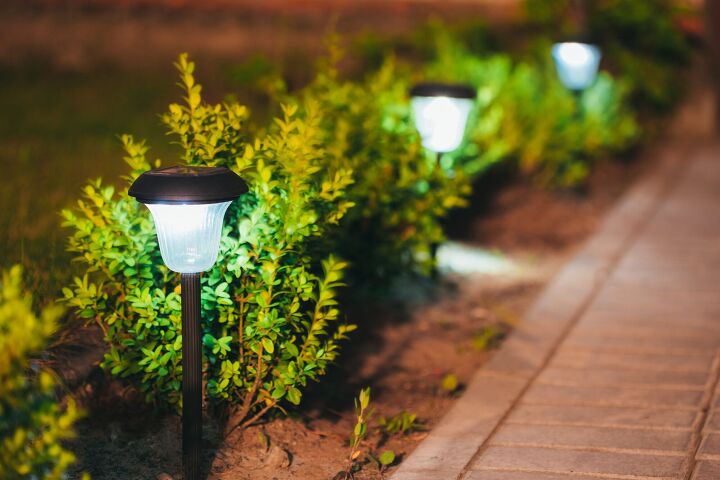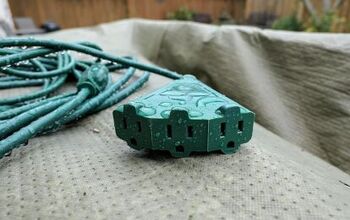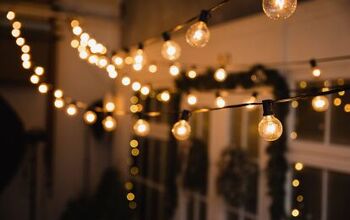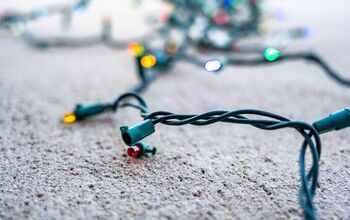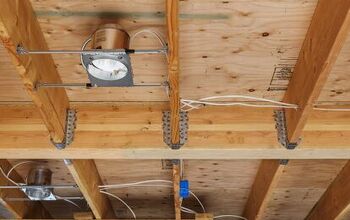Can Solar Lights Be Charged Indoors? (Find Out Now!)

Outdoor solar lights are a wonderful way to enhance the beauty of your property. They are not connected to the grid, which makes them an eco-friendly solution for reducing your carbon footprint. Not to mention, you can virtually eliminate your electric bill for your lighting in your garden, lawn, patio, and the exterior of your home.
However, these lights present a challenge in the winter months when the sun is hidden behind dense clouds. You may find yourself asking: Can solar lights be charged indoors? Or, how can you make solar lights work more efficiently with the lack of sunlight in the winter?
Fortunately, most outdoor solar lights are lightweight and can be easily brought indoors to charge. From using incandescent light bulbs, LED light sources, and simply placing them in a window sill, there are a number of ways that you can charge solar lights indoors. With or without direct sunlight, there are methods for charging up your sun-powered lights and other devices.
We’ll walk you through some of the strategies for charging your solar lights both indoors and outdoors, as well as maximizing their efficiency during winter months.
Don't want to do it yourself?
Get free, zero-commitment quotes from pro contractors near you.

How Does Solar Light Work?
Before we dive in too deep, it’s important to understand how solar power works. Systems that are powered by the sun involve photovoltaic cells, which make up the solar panel that is typically found on the top of lamps This panel collects energy from the sun and coverts it into power that can be used by the batteries or lights – turning them on and operating them for a few to several hours.
How Long Should Solar Lights Be Charged?
For light devices that are powered by the sun to function best, they should receive direct sunlight for four to 10 hours. To maximize the sun’s rays, it’s best to make sure that the solar panel is away from shadows. Once the batteries are fully charged, your outdoor solar light should stay on throughout the night.
There are more advanced solar lights, such as solar street lights, that require six to eight hours to charge. When these lights are fully charged, they can provide lighting for 5 to 7 sunlight-less days.
Can I Charge Solar Lights Indoors?
Yes, solar lights can be charged indoors. Lightweight solar lights that are easy to transport can be brought indoors to charge in a number of ways – from conventional light bulbs to placing the solar lights near a window. You can even use your computer or solar power bank to charge your solar lights if they are outfitted with a USB charger. We’ll discuss these methods in detail below.
1. Incandescent Lights
Incandescent light bulbs can be used to charge solar lights indoors. While it may sound silly to use a hard-wired light to charge a light that’s designed to be energy-saving, it may be necessary when you’re looking to charge your lights indoors. In fact, some people use outdoor solar lights as indoor emergency equipment during power outages. The idea is similar to using rechargeable flashlights when the power is out.
With that said, if you need a substitute for sunlight or simply want to charge your solar lights indoors, strong artificial lighting is a great solution. This method works because solar cells respond to both kinds of light, as they operate at similar wavelengths and light wave spectrum. Incandescent light bulbs can be used to charge any solar powered device you own in the same way that you would charge them with sunlight, including solar flashlights, solar watches, solar calculators, solar lights, and more.
However, it’s important to note that using incandescent bulbs to charge solar lights takes longer than direct sunlight – roughly two to five hours more. To charge your solar lights with incandescent light bulbs, simply position the bulb a couple inches from the face of the solar panel. Depending on the wattage of the bulb, the solar light can be charged for between six and 12 hours. For best results, use bulb that is 40W to 100W.
2. LED Light Sources
To charge solar lights indoors, you can essentially use any type of lightbulb that creates light within the proper light wave spectrum. For example, LED lights produce light with visible light, ultraviolet waves, and long infrared waves – each of which the sun also produces. However, like incandescent bulbs, LED bulbs only release a small number of ultraviolet waves.
Although the light waves produced by LED lights are not as similar to sunlight waves as those produced by incandescent bulbs, you can still use LED lights to charge solar lights indoors. You will need more LED lights to charge than you would incandescent bulbs, and they will take longer to charge your devices.
When it comes to using LED bulbs to charge your solar lights, try to opt for wattage that’s closer to 100 than 40. Solar shades are better than roller shades and maximize efficiency.
3. Place Near Windows
Although charging your solar lights near a window is technically using the sunlight, it can be considered indirect sunlight charging. One of the best ways to charge your small solar-powered electronics, appliances, and lights indoors is to place them by a window. Simply place the solar cell portion of the device right on the window sill for the quickest, most effective charging.
Believe it or not, this method can still work even on gloomy, cloudy days. In fact, solar panels are known to charge more effectively in colder temperatures. On these days, there is still a small amount of light that will hit the receptors of the PV cells on your solar lights. These receptors are responsible for receiving, storing, and converting energy – regardless of distance and the amount of heat that exists in the environment.
This, paired with cold temperatures, means the electrons inside of the solar panels will not have excessive electron movements. As a result, it creates a higher voltage difference and, thus, more energy production. Therefore, even if the sun is hidden behind clouds, your solar lights can still be charged.
4. Alternative Charging Method
Some solar lights come with an alternative charging method via a USB charger. This allows you to simply plug the light into an indoor wall socket or a power bank. While this option may cost you more than any of the other aforementioned indoor charging methods, it may be more convenient depending on your situation.
Can You Use UV Lamps to Charge Solar Lights Indoors?
If you would prefer to use ultraviolet lamps to charge your solar lights, this is possible but there are some things that you should be aware of. For starters, UV lamps produce substantially more energy and heat than the average indoor light.
When used indoors, this can present a major safety hazard. For this reason, we highly recommend steering clear of UV lamps when you want to charge a solar light indoors and opting for a different source of light instead.
Don't want to do it yourself?
Get free, zero-commitment quotes from pro contractors near you.

More Effective Solar Light Charging During Winter
When solar powered lights don’t have enough sunlight to charge completely, this does not mean they are useless on a cloudy, wintery day. Solar panels are designed to optimize energy harness in the daylight hours, even when the sun doesn’t show up. Though, you will end up with less energy stored in the battery. The following are some tips you can follow to ensure that your solar lights work more effectively during the winter months:
- Keep the solar panel surface clean. Snow, dirt, and dust can collect on the surface of the solar panels. This makes it difficult for the panel to harness the energy from the sun. To help it charge better during winter, keep the surface as clean as possible. Soak a microfiber cloth in water and wipe the surface clean, as needed.
- Adjust the angle of the solar light. It’s important to make sure that the angle of your solar light’s panels are facing the direction of the sun – especially during the winter when there is far less sunlight. You may need to readjust the panels so that they receive more sunlight. For best results, avoid placing the lights under trees or near shadows and try to aim for 8 to 10 hours of charging under full sunlight.
- Try using a mirror to redirect the light. Using mirrors to redirect sunlight to your lights is an effective way to optimize sun rays in the winter. Though, this can pretty labor-intensive as you have to adjust the mirrors constantly throughout the day. For best results, opt for mirrors that are larger than the solar panels so they can take in more light. Also, position the mirror diagonal from the ground so it doesn’t have to be placed above the solar panel.
- Turn off the solar light. Shutting off your solar light and allowing it to charge for approximately 72 hours is known as deep charging the battery. Do this about once or twice a month to keep your solar batteries functioning more efficiently.
Solar lights use the energy from the sun, but it doesn’t necessarily have to be direct sunlight. This means that even on a cloudy day or indoors, you can still charge your solar lights. When sunlight is not an option at all, there are plenty of alternative light sources that can be implemented.
Related Articles

Jessica considers herself a home improvement and design enthusiast. She grew up surrounded by constant home improvement projects and owes most of what she knows to helping her dad renovate her childhood home. Being a Los Angeles resident, Jessica spends a lot of her time looking for her next DIY project and sharing her love for home design.
More by Jessica Stone



